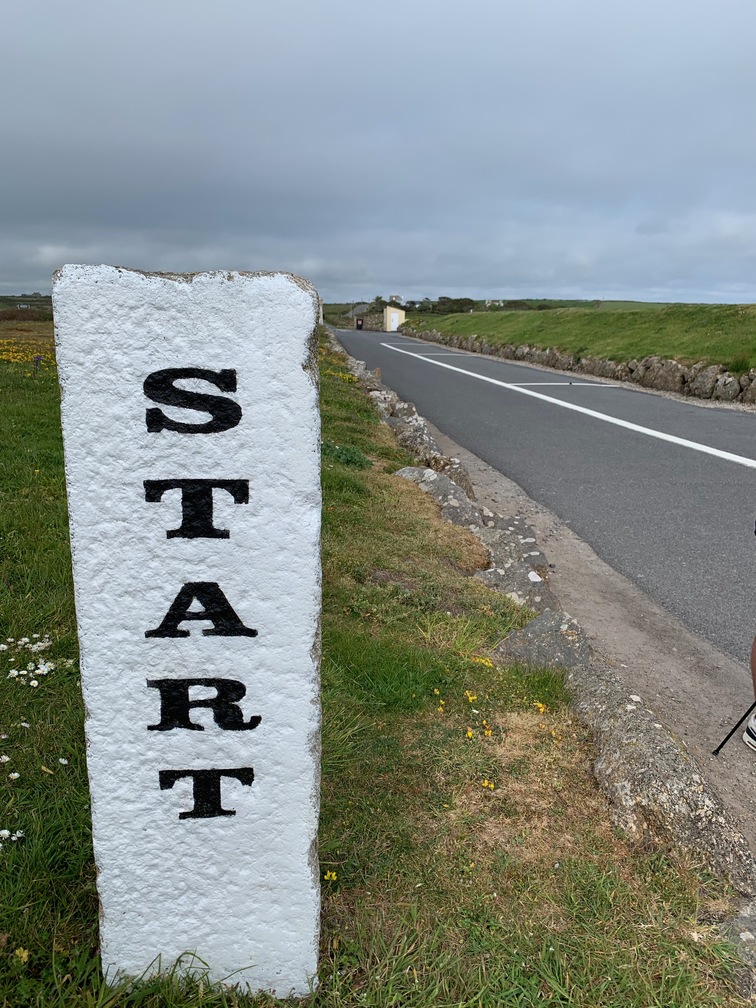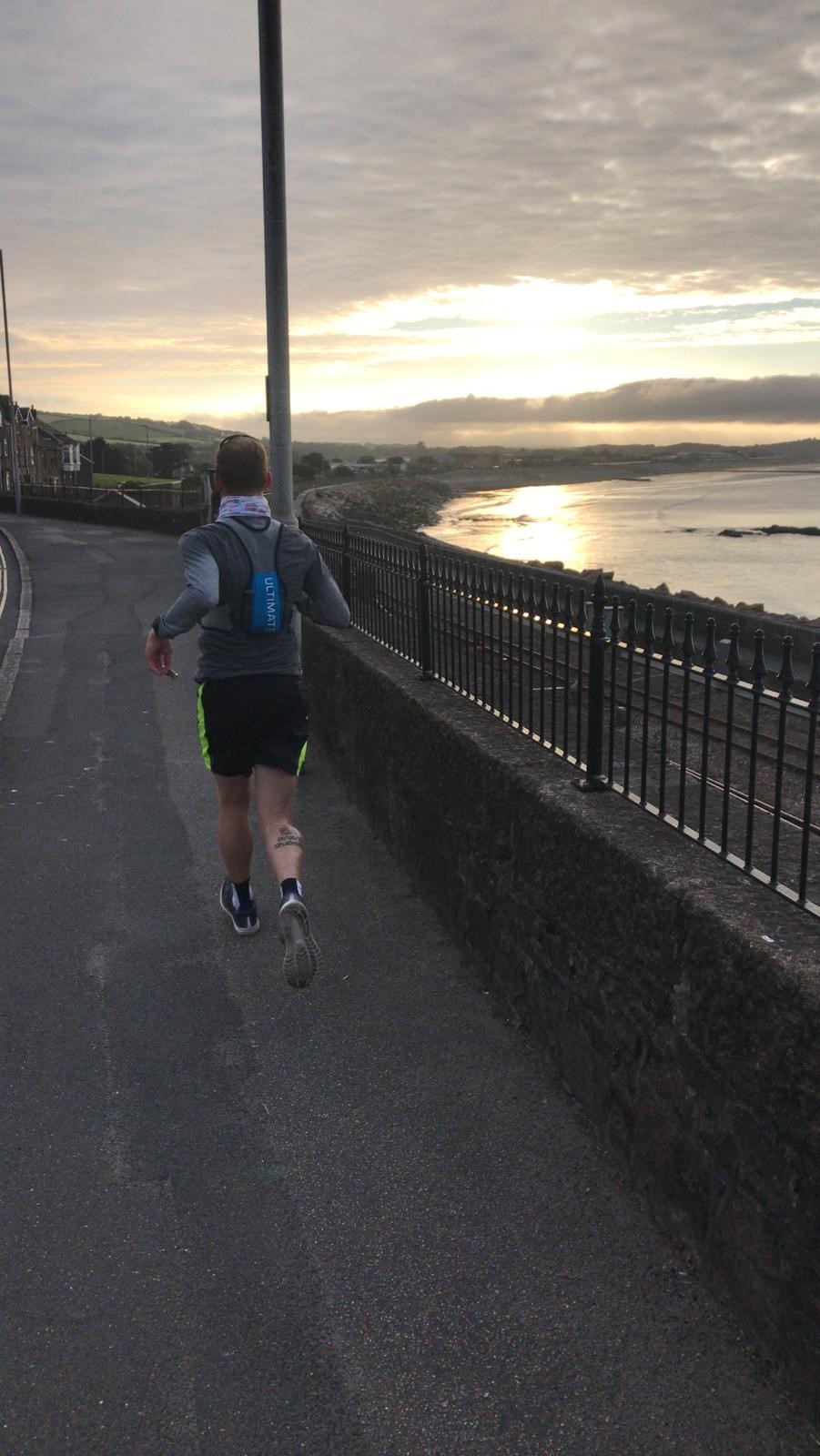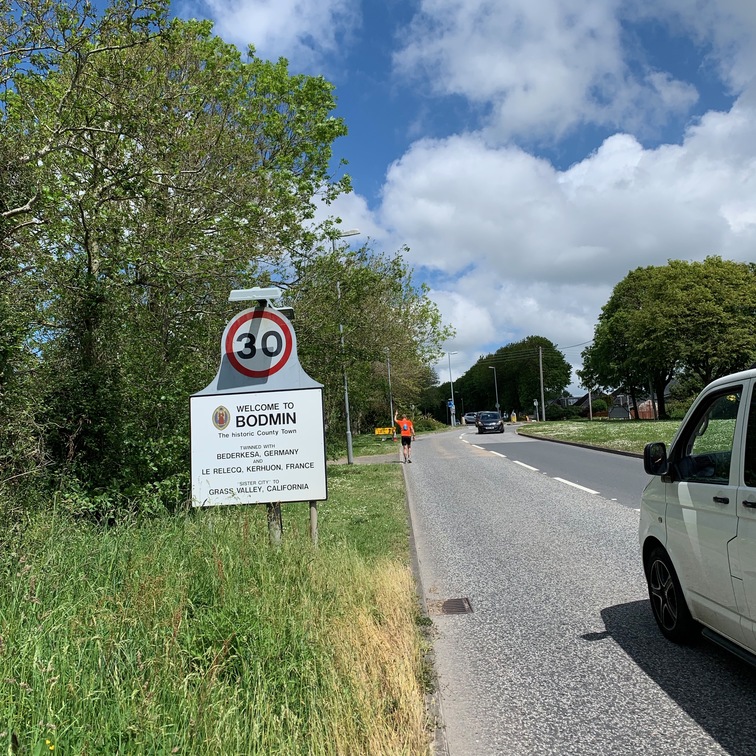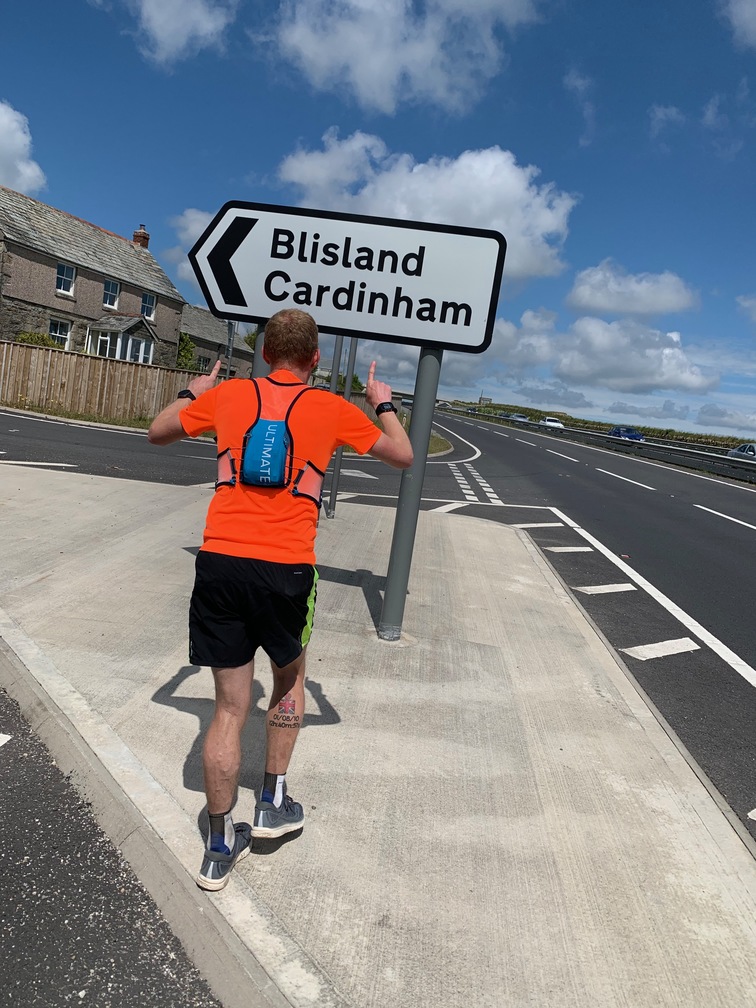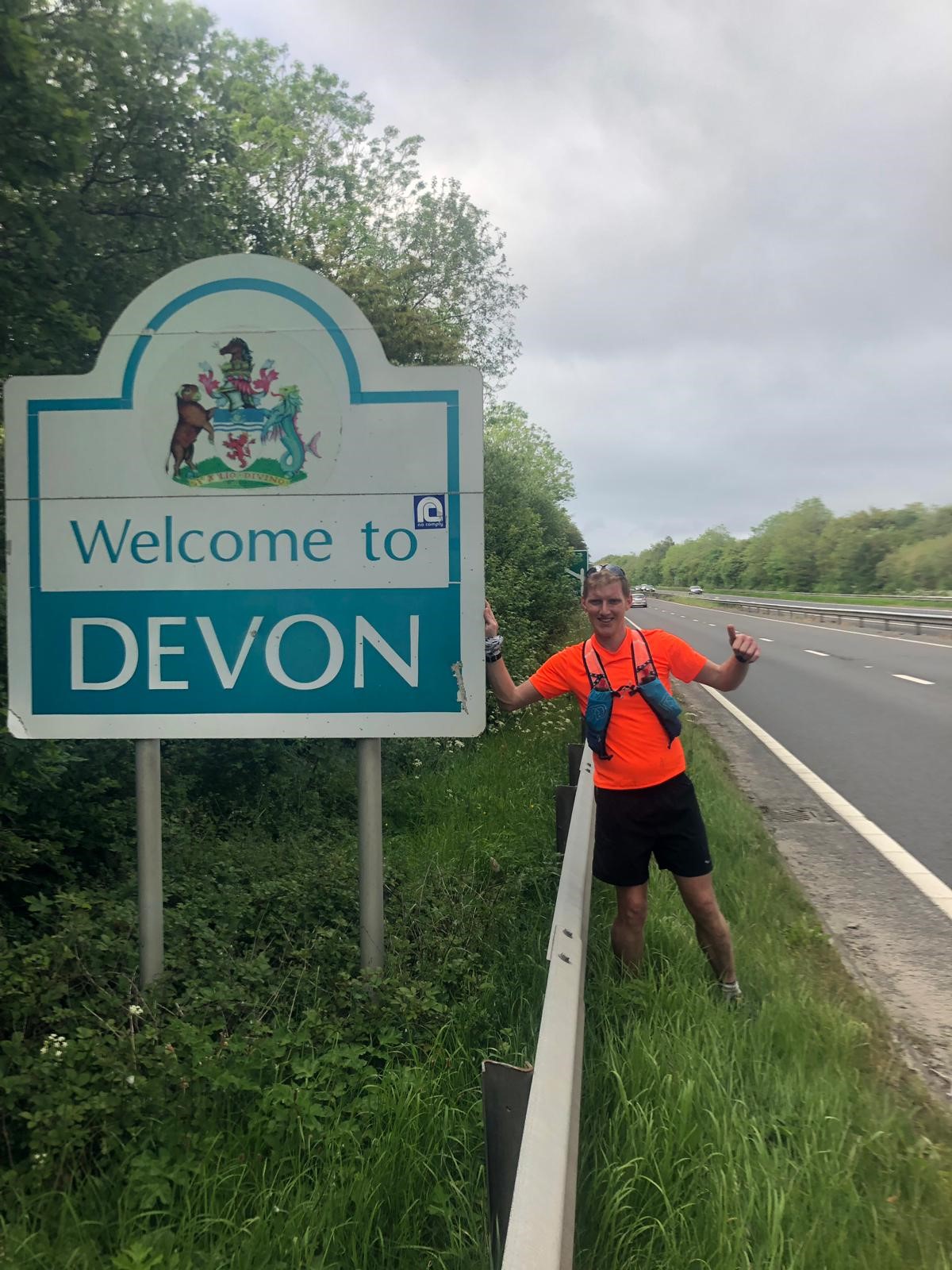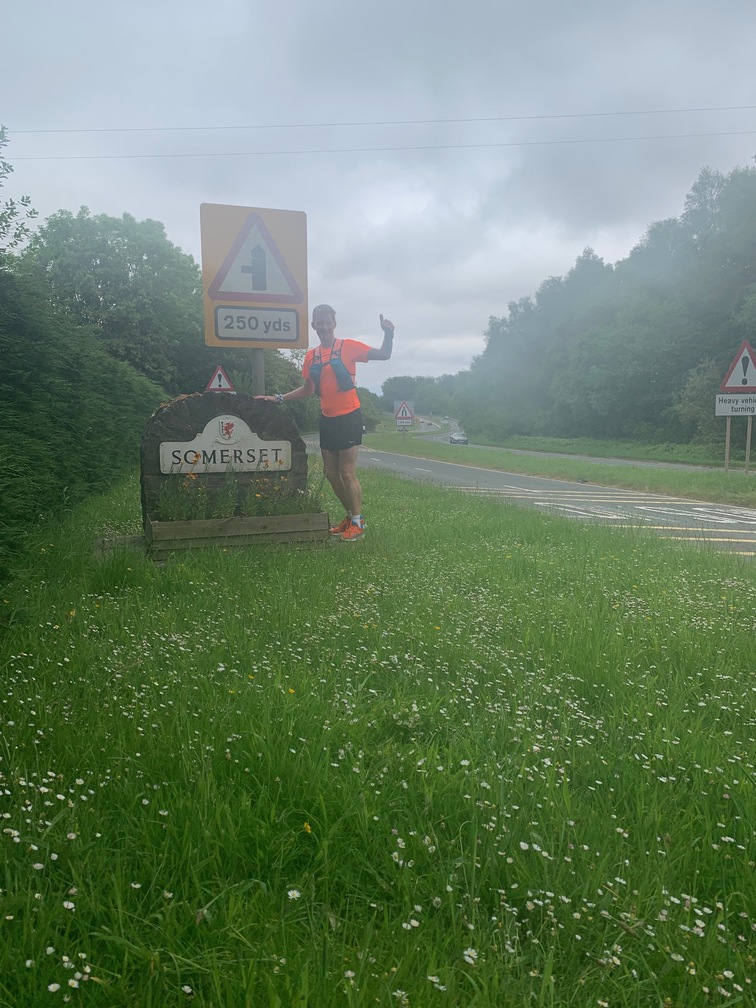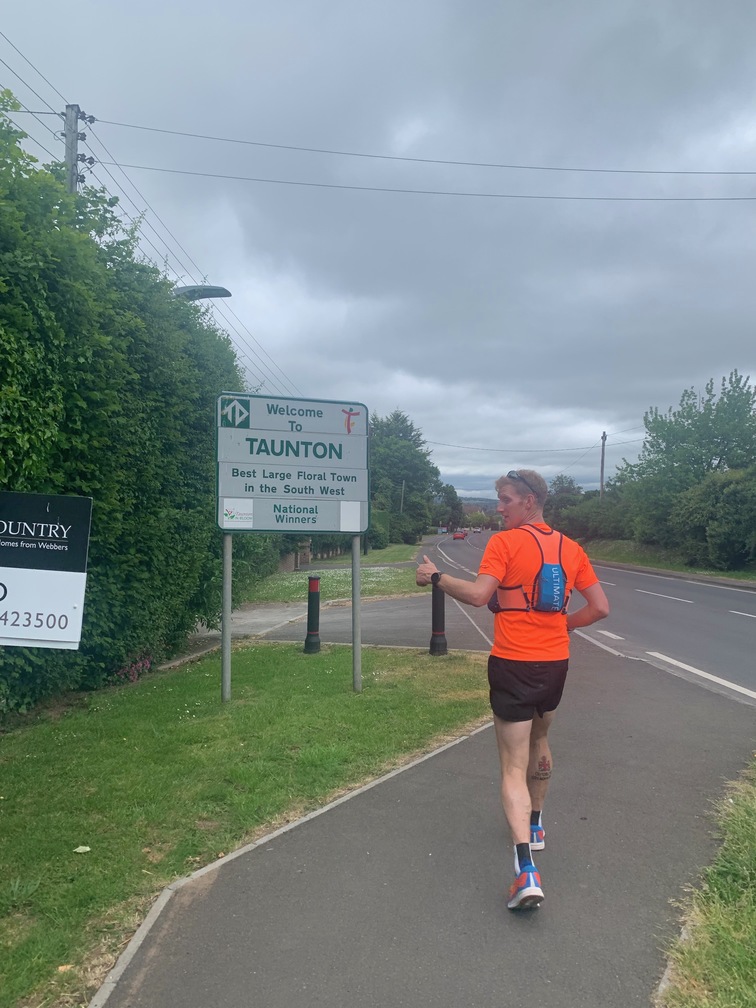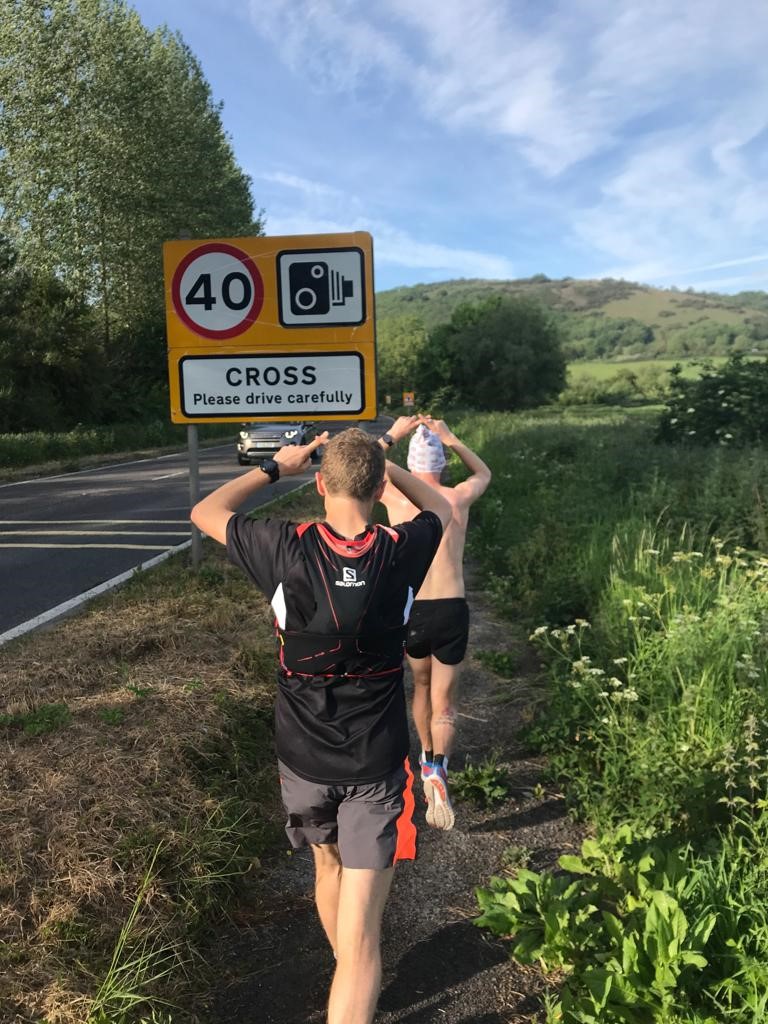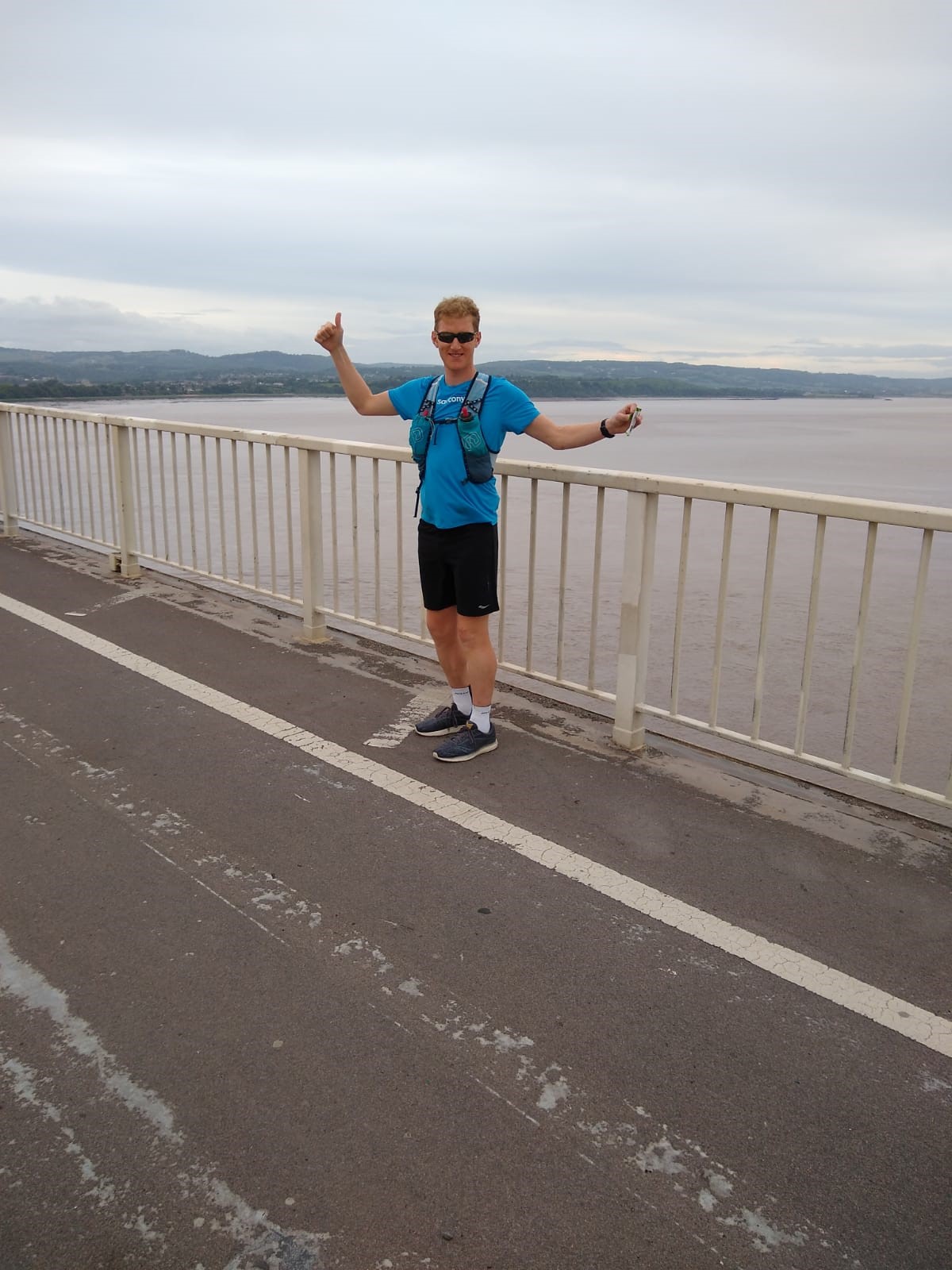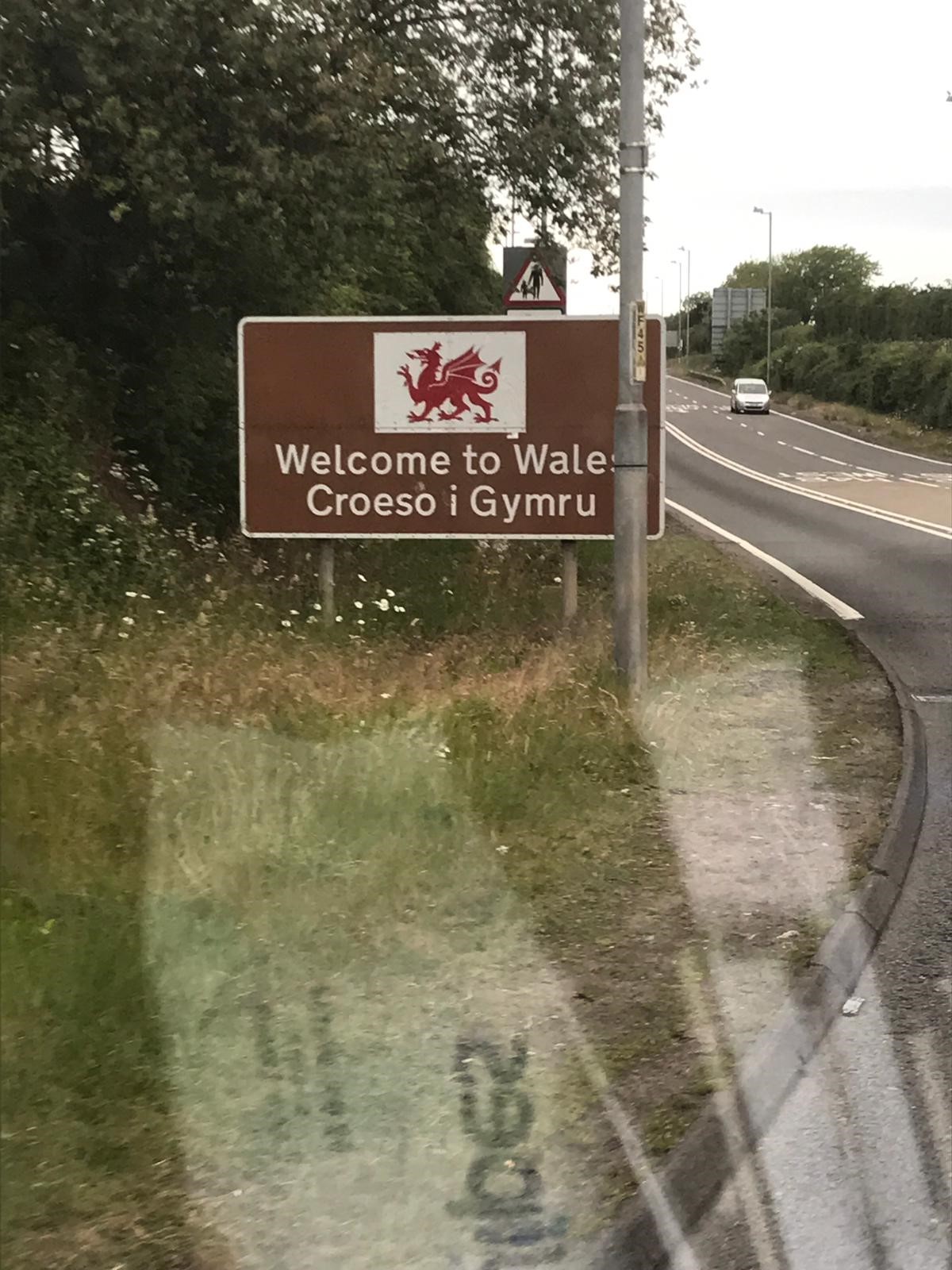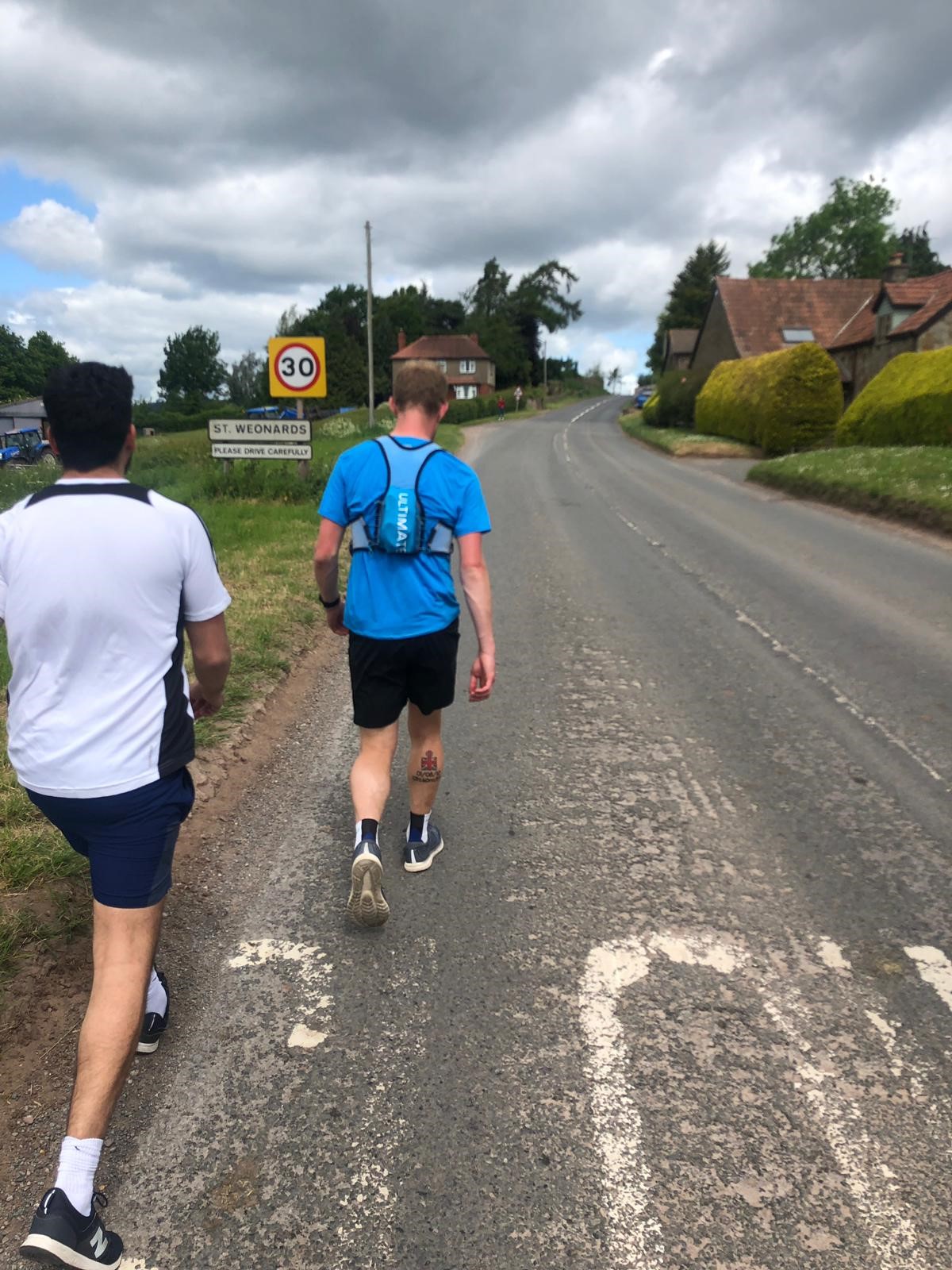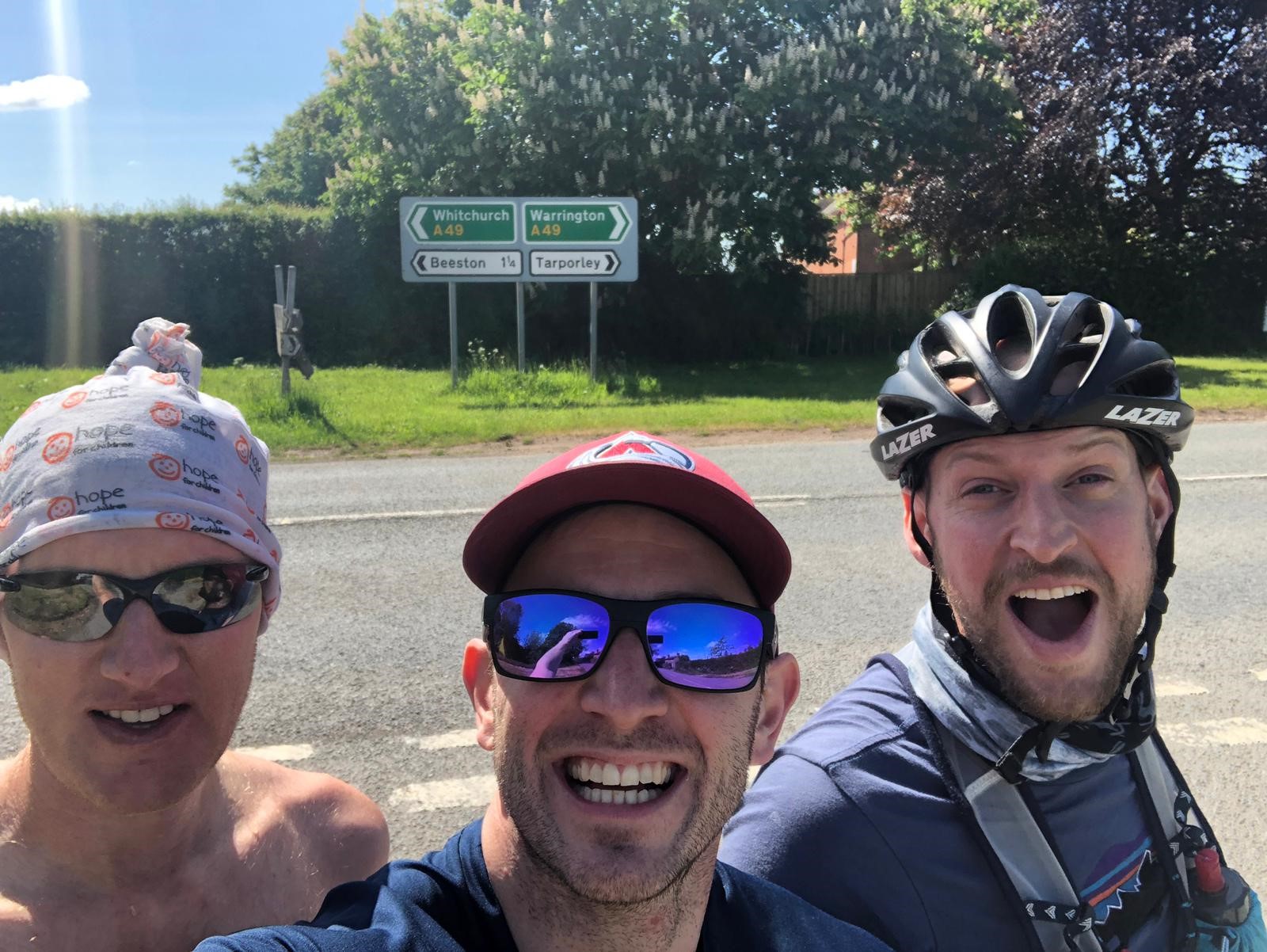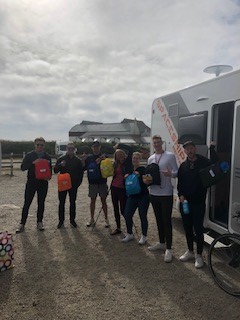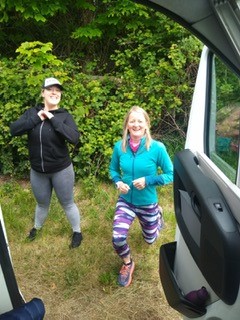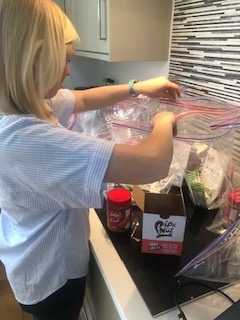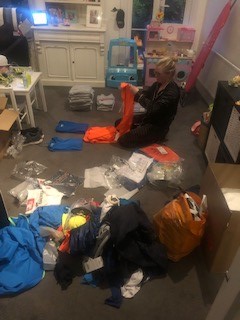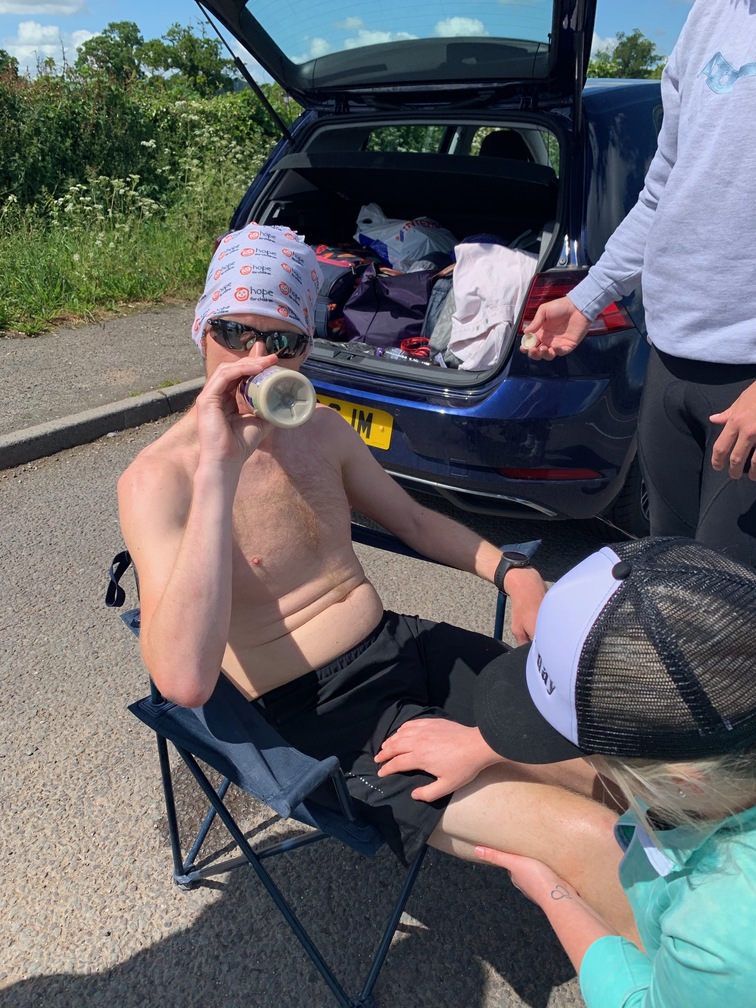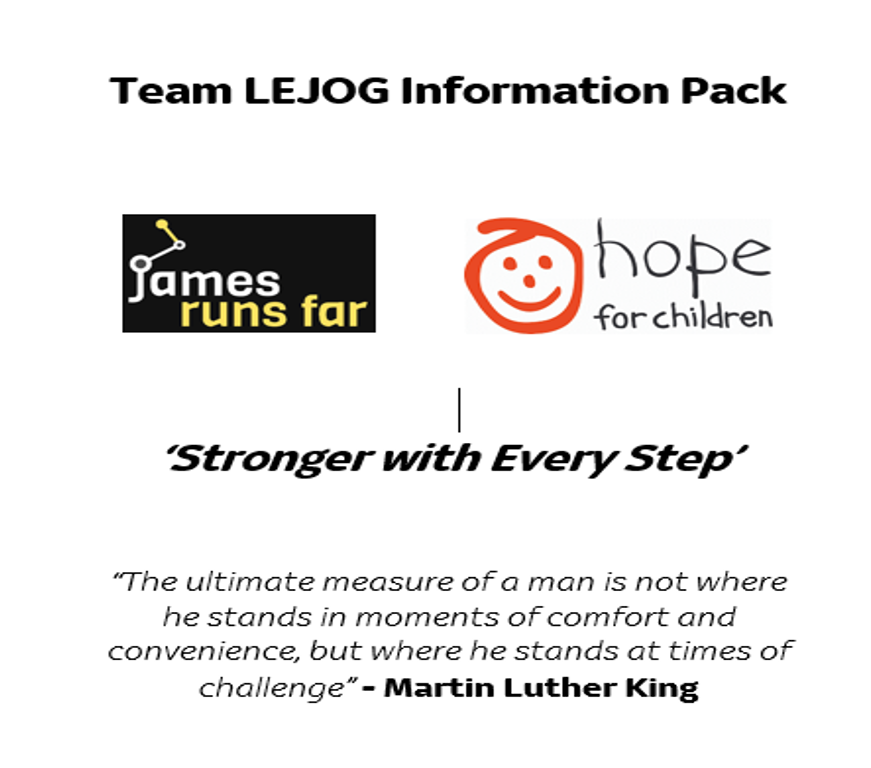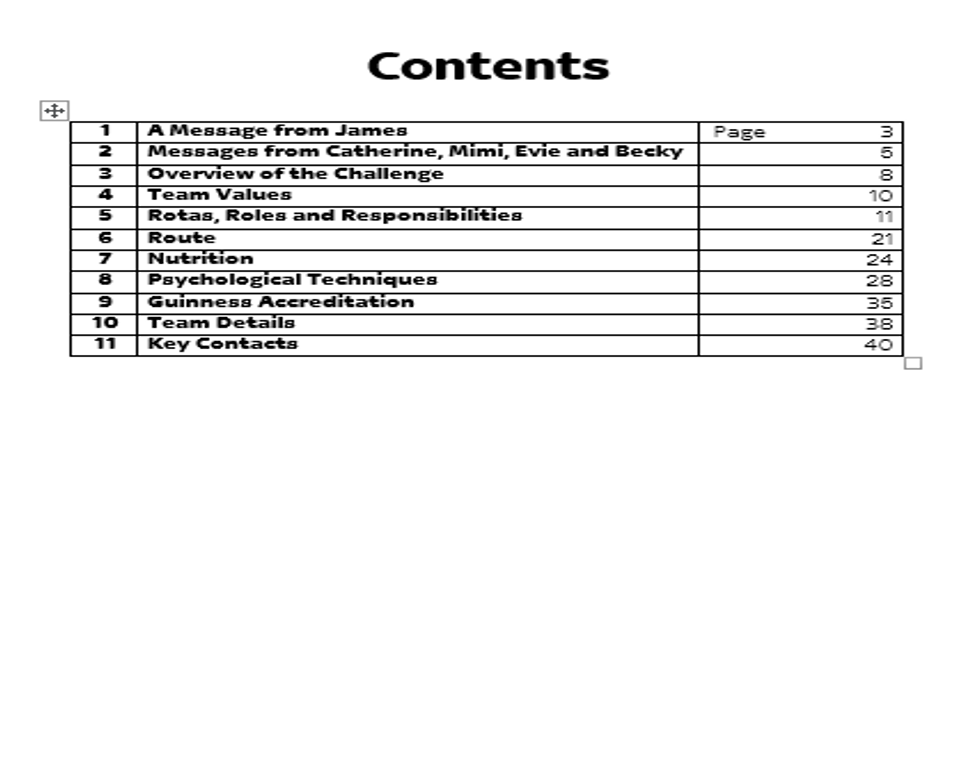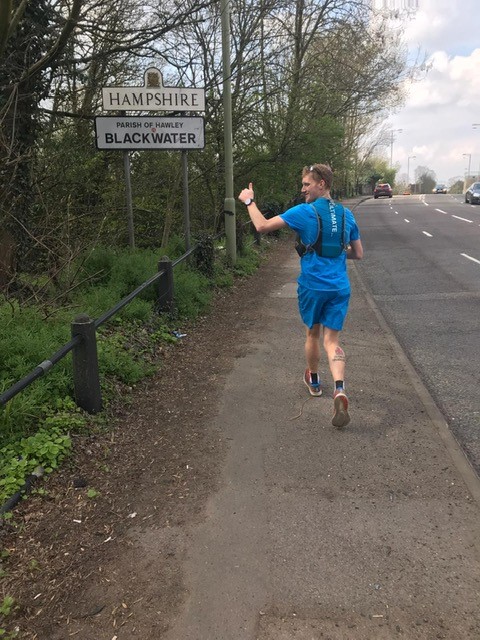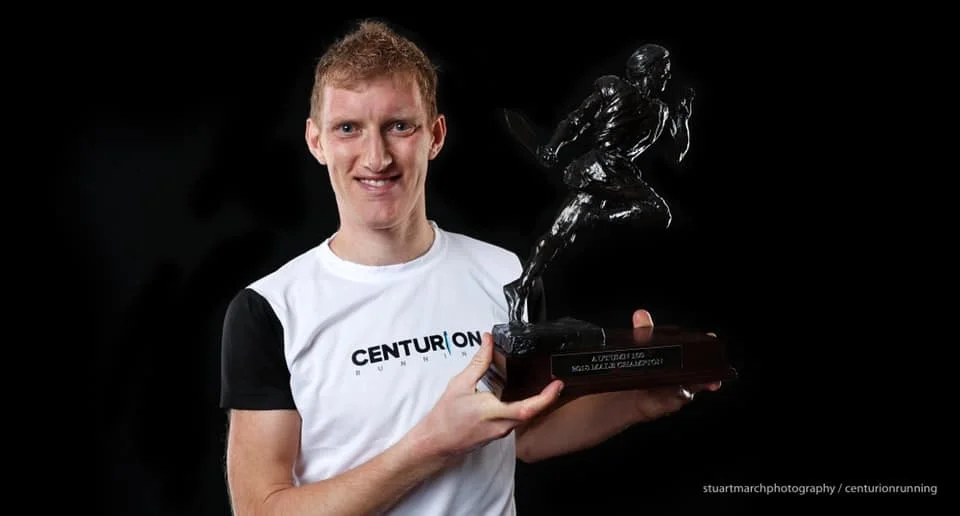“Winning is great, sure, but if you are really going to do something in life, the secret is learning how to lose. Nobody goes undefeated all the time. If you can pick yourself up after a crushing defeat, and go on to win again, you are going to be a champion someday. ”
I failed.
There’s no hiding from it.
My number one goal that I worked towards over the past 18 months was to break a world record.
And I didn’t do it.
After 377 miles of running in just over 4 days, I ended my attempt to run from Land’s End to John o’ Groats (LEJOG).
This was my proposed route, including daily stops (the red dots) on my world record attempt to run from Land’s End to John o’ Groats
And despite having one of my best running sections of the entire event at the end of day 4, I woke up on day 5 with barely any energy in my legs.
I trudged around for 9 hours just north of Preston at a pace that a snail would be embarrassed by.
And finally, when the record was clearly out of reach, and there was little chance I would even complete the journey in an acceptable time, I told my team that I wanted to quit.
Me looking over the beautiful sunset at Land’s End, the day before my attempt started. At this point, I was confident and calm. And even though I knew how tough this was going to be, it was tougher than anything I have imagined
Me in a moment of pain, walking during my attempt
Since that point I’ve had time to think about the 18 months leading up to the attempt, the 4 days during the attempt, and the aftermath of the event.
You can read more about the background here.
And you can see the updates that happened during the challenge itself on my social media accounts below.
There’s also still time to donate to the charity I was raising money for, Hope for Children.
Please spread the word and tell others in your network too!
If you donate by Friday 21st June, you will get an entry into a prize draw to win a 55 inch UHD TV! (UK only)
Change a child’s life by donating to Hope for Children. And get entered into the prize draw to win a 55 inch UHD TV! (UK only)
Why Have I Written This Blog?
Why am I writing a blog about something that I failed at?
Why bring up the bad memories and disappointment from Wednesday 29th May, when I decided to stop?
Why not just brush this under the carpet, ignore it and focus on my next event?
There are a number of reasons for writing about my experience.
“Shoot for the moon. Even if you miss, you’ll land among the stars.”
To inspire people to set huge, ambitious goals - When you set huge goals and objectives, you are also likely to fail to hit them. But that’s what it takes to push yourself out of your comfort zone. And even if you don’t hit your primary goal, you will achieve a huge amount on the journey.
To give an insight into how much planning and preparation goes into trying to achieve huge, ambitious goals - The first step is to set yourself a huge goal. But the second, more important step, is to put a plan in place to try to achieve that goal. My LEJOG attempt included a huge amount of physical training. But it was also a massive logistical project that involved many people and a huge amount of planning. And hopefully others can learn from it.
To show others that it is OK to fail - Failure is never the outcome that anyone wants. But it is often the first step in a journey to something bigger and better. I am certainly hoping that’s the case for me.
To show other people that you can take positives from a negative experience - This wasn’t just a failure that I experienced on my own. My family, friends and thousands of people in the wider ultra-running community have seen me fail. But there are lots of positives that I am taking from it. I am not sitting around in self-despair like you might imagine. But I will also be thoroughly analysing the event so that I can learn and improve in future challenges.
To raise money and awareness for Hope for Children - One of my biggest objectives was to raise money for a great cause. You can still donate to Hope for Children, here.
This blog isn’t meant to make people feel sorry for me.
Or to try to make people say things like “oh, but you didn’t fail, because you achieved so much”.
This blog isn’t meant to be a detailed review of the actual journey, either.
I’m not going to include the specific places I ran, or all of my highs and lows.
I didn't think that would be very useful or interesting for most of you.
But, if you are interested in that, let me know in the comments at the bottom of this blog, the contact page or on social media below.
“This blog is about learning from the negative aspects of my attempt and focusing on the positive aspects for the future. And hopefully others can learn something too”
But here are a selection of pictures from some of the amazing major landmarks I ran past
Save Time, Money and Effort by Claiming Your Free Training Plan Template
Join hundreds of other athletes who get amazing benefits, simply by providing your email.
A FREE training plan template - Which will save you time, money and effort when creating your plans
The best training and racing advice from across the web - I send these articles out every month, exclusively, to email subscribers
Early access to exclusive offers and deals - I send out the best discounts and offers to email subscribers first, before anyone else
A Massive Thank You
Before I get into the details of my LEJOG attempt, I want to say a huge thank you to a number of people.
I couldn’t even have got to the starting line of LEJOG without them.
And I certainly wouldn’t have got as far as I did during the challenge itself.
My Family
Particularly Catherine, my wife. For her unwavering support over the past 18 months for me to try to achieve my dream.
And there were many other family members who supported me - including Catherine’s parents (Bill and Cynthia) and the Gould family.
My family were hugely supportive during my LEJOG adventure. They even came and joined me for the challenge itself. Here I am seeing them all for the first time. From left to right: Rosie (my daugher), Bill (my father-in-law), Lottie (my daughter), me, Catherine (my wife) and Cynthia (my mother-in-law)
My Team
This includes the 7 people who were there with me during the attempt. Plus those who had helped over the past year and a half, but couldn’t make the event itself.
The full list of the team can be found on the LEJOG page.
I also want to say thank you to the partners of several of my team members - Harriet Danby, Colette Mounsey and Heather Tillman.
It was a huge commitment for three of my best friends to join me during the challenge. But it was also a huge commitment for their partners.
The same goes to Paul George, whose wife, Becky, joined us for 3 days. Just before their wedding anniversary!
The Community
I’ve been blown away by the positive energy from every single person that this challenge has touched.
From people giving their motivational support on social media to those who joined me on the run itself.
I imagined that there would be a lot of negative comments from people.
But that hasn’t been the case.
Instead, there have been countless supportive messages and people saying they have been inspired by the attempt.
Thank you
I was amazed at how supportive the entire community was in my attempt. Many runners joined me throughout the challenge. And here was the first person who joined me on day 1, running on the busy A30 in Cornwall. Thank you to everyone
Phil ran with me through the night on Day 4, which was one of my best sections of the entire attempt.
Lots of people joined me for the attempt. And it was strange that I lost a lot of energy as soon as they left. It shows how important supporters are for a challenge like this!
Saucony
I also want to give a huge thank you to my shoe and sports kit sponsor, Saucony.
I’ve loved Saucony running shoes for years. My favourite shoes have been the Kinvara. And I run in the latest model, the Kinvara 10.
And so I’m really proud, and privileged, to say that I’m now a Saucony ambassador.
The brand is the perfect fit for me and I’d like to give a huge thank you to Saucony for their support over the past 6 months.
Sky
Finally, my employer, Sky.
It felt like the entire company got behind my attempt.
I was offered flexibility in my working schedule, supportive messages and even funding - this type of project isn’t cheap!
There is absolutely no way I could have got to where I did without Sky’s support.
18 Months in the Making
Setting yourself a massive goal is the first step to seeing how far you can push your limits.
But putting in the hard work preparing for that goal is the important part.
My LEJOG dream was planned for more than 18 months.
In the time frame I gave myself, I did almost everything I could to put myself in the best position to achieve my goal.
Ultimately, I came up short.
But I don’t think it was due to my lack of preparation.
And there’s not much I would have changed in this part.
I wanted to give you an insight into the amount of planning that goes into something like this.
And I hope that it will help others plan for their own challenges.
The principles I used are applicable to most challenges. Even if they’re not on the scale of my LEJOG attempt.
Throughout my planning, I grouped everything into four areas. These are also in the order I thought was the most important.
The Training
The Team
The Logistics
The Promotion
Training
The main aspect of this challenge was trying to get myself into the best physical shape to run 800+ miles in 9 days.
As a starting point, I looked for the best possible coach I could.
And I found her - Mimi Anderson.
Mimi Anderson was the ideal coach for my LEJOG attempt.
Mimi is the women’s world record holder for running from John o’ Groats to Land’s End (the reverse of my route).
And she has a number of other impressive achievements on her ultra-running CV.
Which made her the perfect fit for me.
Not only did she know the physical demands of the challenge. But Mimi also gave advice on the logistical side of LEJOG.
From a training point of view, I started preparing specifically for LEJOG about 12 months before.
My training plan in that year included:
4am starts every day for 6 months - including rest days, so that I kept my body in that routine
300+ mile weeks
51k commute runs to work
Back-to-back training weekends of 80 miles on one day and 80 miles the next day
100km and 100 mile races - some of which I won
And as well as the physical preparation, I needed to ensure I was ready psychologically too.
I worked with Evie Serventi, my sports psychologist, on this for more than 18 months.
We worked through a range of tools and techniques that I could use in the build up to the challenge, and during the challenge itself:
Visualisation
Trigger words
If/ then strategies
Alter egos
I’ve talked about these techniques in detail in other blogs like this one and this one.
Athletes who are looking to take their performance to the next level should definitely look into getting a sports psychologist.
You can contact Evie through her website if you’d like to find out more about how she can help you achieve your goals.
Evie Serventi was my sports psychologists. Her work meant that I had very few struggles mentally in the build up to the event, or during the event itself. You can contact her through her website to see if she can help you achieve your own goals
The third aspect of training was my nutrition.
I’ve been on a high fat, low carb diet for more than 2 years.
And I’ve found huge benefits to my running.
The theory is that you should train your body to use fat as an energy source when exercising for long periods of time.
This is because your body has a lot more calories stored as fat than carbohydrates.
So if your body is more efficient at using fat as an energy source, it has a lot more calories that it can use.
As you train your body to become more ‘fat-adapted’ you rely less on carbohydrates, and don’t experience things like ‘bonking’ or ‘hitting the wall’. Which often happens because your body has used all of the carbohydrates stored in your body.
You can help your body become fat adapted even more by training at low intensities. Which is what nearly all of my training was for LEJOG.
I also did other things like fasted long runs.
This is where I did long runs without eating or drinking before, or during, the run itself.
Team
After the physical training, the team that I built around me was the most important part of this challenge.
My team included those who supported me in the build up to the event...
Catherine - My wife: As well as encouraging me to attempt the challenge, and doing more than her fair share of looking after our family, Catherine is an ex-runner and supported me during multiple ultra-races. She helped me test various nutritional approaches, including my secret high-fat smoothie, and other high fat, low carb meals and snacks
Evie Serventi - My Sports Psychologist
Mimi Anderson - My Coach
And I also needed a support team to be with me during the challenge itself...
Running for 18-20 hours a day for 9 days would mean that I wouldn’t be able to think about much apart from putting one foot in front of the other...
… Which meant that I would rely on other people to feed me, tell me the right direction to go, tell me when to rest, when to sleep, when to massage me and how to motivate me.
This was a huge responsibility.
And so I had to have people on my team that I trusted 100%.
7 people supported me during the challenge.
And every single one of them were exceptional in the build up, and during the challenge itself.
6 of the 7 crew members had no experience in ultra-running. And no experience crewing in events like this.
The crew members were (in alphabetical order):
Ben Cooper - One of my best friends, who had committed to the challenge more than 18 months ago. Ben has run marathons and knows me better than almost anyone else.
Rob Clayden - A sports journalism student from St Mary’s university where I had done some work with the sports science department. Rob heard about the challenge and volunteered to be a part of the crew. He has a passion for social media which was a massive factor in raising so much money for Hope for Children
Jack Donaldson - Another of my best friends who committed more than 18 months ago. Jack has completed an Ironman triathlon and is an excellent motivator, who knows exactly what to say at the right time
Becky George - The only person who had any experience in ultra-running, or crewing for endurance events like this. But I couldn’t have picked someone with better experience. Becky has crewed for my coach, Mimi Anderson, in several of her huge adventures. Including her record breaking John o’ Groats to Land’s End journey. Becky joined us for the first 3 days and showed us exactly what this sort of attempt required from the team. Her input in the build up to the attempt was also hugely important.
Thomas Kaiser - Another sports journalism student from St Mary’s university, who volunteered to be part of the project. Thomas wrote the best article that covered my event. Which was much better than some of the journalists from national newspapers!
Jamie Riddett - Another of my best friends who agreed to the project more than 18 months before it started. Jamie has completed numerous triathlons and marathons and is an excellent project manager. Which made him the perfect person to take the lead role from Becky on day 4.
Kerry Tibby - A trained sports masseur, who has crewed on multi-day cycling endurance events. Kerry was the perfect fit for my team in terms of her personality. And she also had the least envious job of managing my blistered feet... and massaging me as I fell asleep at night! If you’re in London and in need of a masseur, get in contact with Kerry on her website.
I couldn’t have picked a better support team.
None of us could have imagined how intense the event was going to be.
And all of the guys handled it incredibly well.
Logistics
The logistical planning behind an event like this is immense. And it was the biggest personal project that I have ever taken on.
Here were some of the things that I worked on in the 18 months leading up to the attempt:
1) The Route
Because this was a record attempt, getting from point ‘A’ to point ‘B’ in the most efficient way possible is critical.
And i created numerous ways for me and my team to access the route.
The simplest was Google Maps.
Selecting ‘Land’s End’ as the starting point, ‘John o’ Groats’ as the end point and ‘walking’ as your mode of transport is 95% accurate.
But it does try to take you down private roads. And tries to make you take some very dangerous turns as a pedestrian (across huge ‘A’ roads for example).
Plus, it takes you down some roads that aren’t suitable for vehicles.
So I spent weeks going through Google Streetview turn-by-turn marking up all the key points for myself and the vans.
I then used the Ordnance Survey app to create a specific route which we could all download offline, for when we couldn’t get signal.
Plus, I printed off key difficult sections, like major towns.
I scoped out potentially troublesome areas on the route using Google Streetview and Ordnance Survey and provided print outs for my team.
This was an example of entering Bristol
Although this was hugely tiresome, it was definitely worthwhile.
I wish I had done it earlier and checked it with more experts.
Because, after the attempt, I was told there were better routes which were slightly longer, but significantly less hilly.
If I ever attempt something like this again, I would recce the route beforehand.
2) The Logistics
A team of 7 people with food, clothes and equipment for someone running more than 800 miles in 9 days (plus stuff for themselves), requires significant transportation.
I’d always planned to use two motor homes and a cyclist to support my challenge.
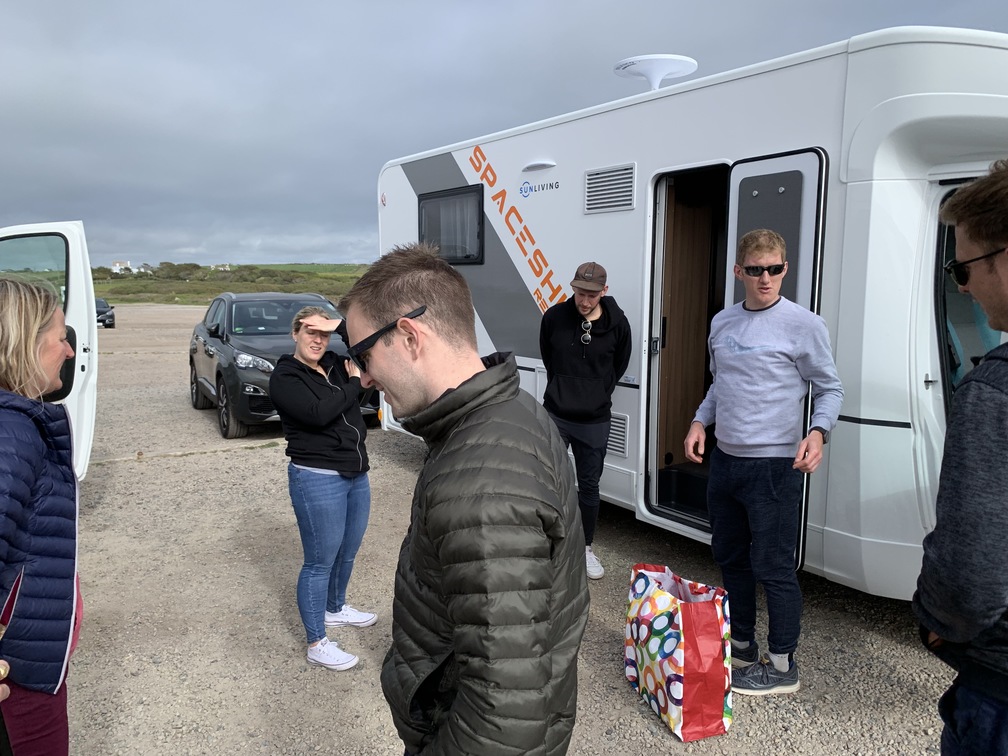
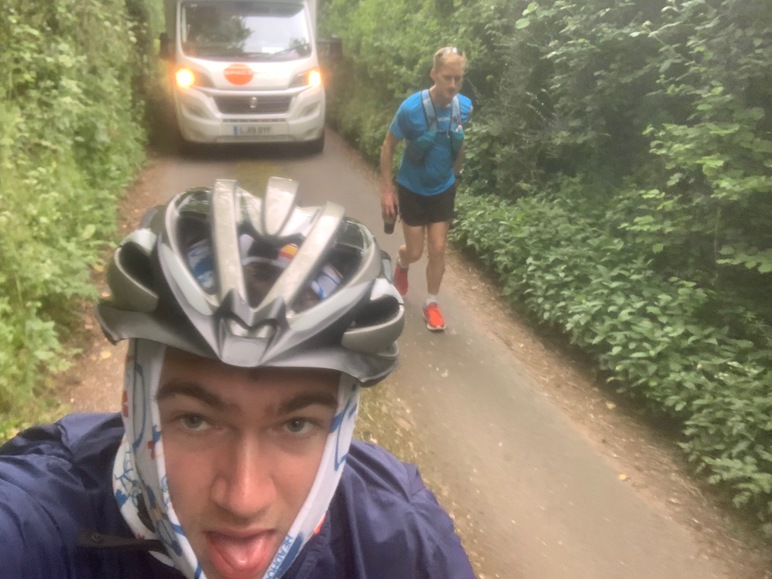
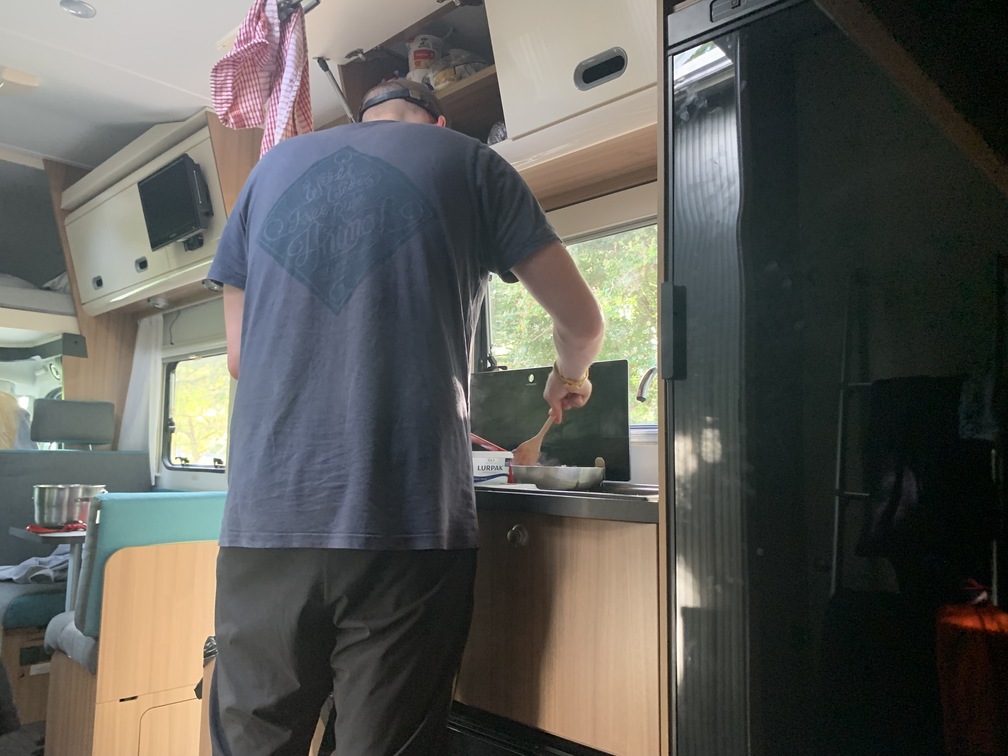
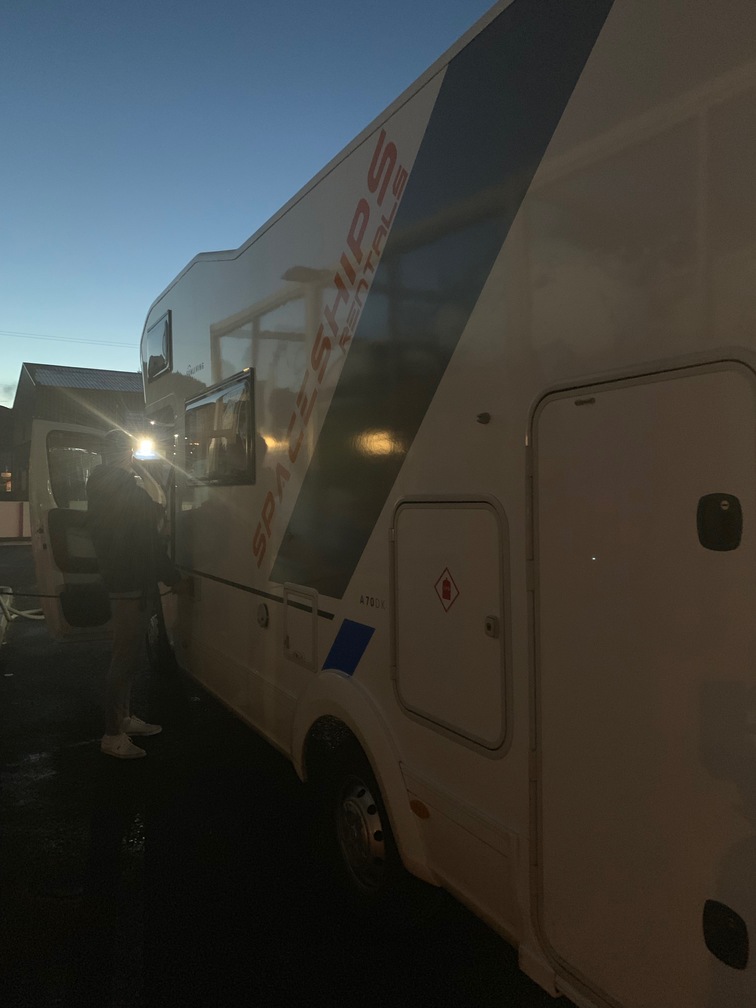
One of the vehicles leapfrogged me every 3 - 5 miles and supported me with smaller food and drink requirements as well as helping with navigation.
The other motor home leapfrogged every 25 miles, cooked my main meals and allowed the crew to get some well-deserved rest.
I also had a cyclist with me at all times.
Every 25 miles my crew would switch roles. For example, the cyclist would rotate. So nobody was doing more than 25 miles of cycling at once.
One of the main reasons for having motor homes, was because of the huge amount of stuff we had to transport.
Food - I was losing about 10,000 calories every day and needed to limit the calorie deficit as much as possible. To do this, I had meals and snacks for me for 9 days. We also needed cooking equipment and places to store food, like fridges.
Clothes - I had to prepare to run for 9 days and prepare for all types of weather. I took multiple pairs of shoes, socks, shorts, tops, hats, gloves and lots of high-vis clothes, because I would be running on very busy ‘A’ roads and at night
Equipment - There were a huge amount of chargers, blenders for food and other items
And, everything needed to be organised and labelled.
Which is where Catherine, my wife, came into her element in the last few weeks
3) The Nutrition
When losing 10,000 calories a day, you have to have a solid nutrition plan.
I’d tested lots of different nutrition options over the previous 18 months.
Because you never know how you body is going to react to food, when you’ve been running for more than 15 hours a day.
You begin to hate things that you’d normally love.
And you get cravings for things that you’d normally hate.
Trying to look cool at a short stop, whilst having a massage and a blended up smoothie - probably containing cheesecake, porridge, honey and baby food!
I’d been on a high fat, low carb diet for almost two years and had found lots of success with it in running.
So the majority of my food options were high fat.
This meant lots of nuts, nut butters, eggs and meat.
My wife and I created individual packs for each day with snacks for me to have whilst running. which included:
Mixed nuts and raisins from Tesco
Ella’s Baby Food - For when you can’t handle solid foods. I use the sweet ones, not the meals!
Biscoff - which was a special treat if I was unable to eat anything else
Note - If you buy these products using these links you will not pay anything more than usual. And I will receive a very small percentage of the sale.
These snacks were on top of the 5 or 6 bigger meals that I was going to try to eat each day.
These were meals that my team would prepare at the start and end of the day, plus every major 25 mile stop.
And, of course, everything needed organising and labelling!
Despite my high fat approach, I was always intending to be flexible.
Even early in the attempt, I started introducing carbs. A curry with rice cooked by Thomas was the best meal I had.
And by the end of the attempt, I was eating some strange concoctions dreamed up by the team.
Blended vanilla cheesecake mixed with porridge, baby food and honey was one of them.
And, as disgusting as it sounds, it was absolutely delicious.
Get ready for the LEJOG cook book to hit stores near you soon!
4) The Guinness Accreditation
There is a huge amount of documentation that you need to collect for an official Guinness world record.
I received a pack from Guinness which was more than 30 pages long, detailing all of the requirements.
There were a huge amount of requirements to prove a Guinness World Record. This was the 30 page pack that I was sent with details of what to provide
Collecting witness signatures - from people who saw me on the route
Creating a detailed log book - Writing down key details of every 25 mile section I ran - The places I’d run, major things that had happened (if I’d had a break, or had a poo!) and any other detail that would prove that I had done the challenge.
Taking pictures and video - We took pictures of me next to most major signs for counties, towns and villages I ran through. And we had to collect 10 minutes of video footage each day
Uploading GPS data from watches - We did this whenever I stopped for a major break
5) The Team
My team was responsible for a huge amount, despite having little experience of these events before.
My team were responsible for a huge amount during my attempt. Here they are organising some of the paperwork for the route
So I tried to make it easier for them by organising as much as possible in advance.
I created a very thorough ‘information pack’, which included a massive amount of information:
Meal lists
Daily checklists
Guinness documentation
Psychological techniques that they could use
The route
And, most importantly, some inspirational quotes!
“The ultimate measure of a man is not where he stands in moments of comfort and convenience, but where he stands at times of challenge”
We also had a number of team meetings over the final few months to discuss progress, updates and ideas.
And we had three specific weekends where we practised as if it were the real event.
Two of the weekends involved the team cycling with me and supporting me with food and other needs.
And the final training weekend included hiring a camper van and practising the ‘leapfrogging’ technique that we’d use during the attempt.
This weekend also involved me running 80 miles on the Saturday and 80 miles again on the Sunday.
Promotion
One of the most exciting and rewarding parts of Project LEJOG was trying to inspire people and raise money for a great cause - Hope for Children.
The only negative feedback I’ve heard so far about my attempt was about how public I was. And how much media attention I received.
In hindsight, I don’t regret this.
If I didn’t get the coverage, I wouldn’t have raised as much money as I did for charity.
And I wouldn’t have inspired as many people as I did either.
These are two of the biggest positives that have come from the challenge.
I always knew that promotion should be a much lower priority than the training or logistical side of the challenge.
But in the few weeks before the attempt, it significantly increased.
Luckily, I didn’t feel this as additional pressure. Because I had prepared thoroughly beforehand.
And a lot of it was incredibly enjoyable.
My highlights included:
Going on the Chris Evans Virgin Radio breakfast show
interviews on RedBull.com, The Telegraph, Sky Sports, The Sunday Mirror, Athletics Weekly and others
Giving advice on blister prevention in Coachmag.com and on the psychological aspects in Trail Running Magazine
One of the highlights of the last few weeks was going on the Chris Evans Virgin Radio breakfast show
What Went Well?
Despite not achieving my main goal of beating the world record, I am surprisingly positive about my attempt.
I think there were a huge amount of positives to take from the challenge, some of which I am very proud of.
Raising Almost £5,000 for Hope for Children
Hope for Children is a charity that does amazing things for disadvantaged children around the world.
There’s still time to change a child’s life by donating.
And if you donate, you will get added to a prize draw for a 55 inch UHD TV! (UK only).
Change a child’s life by donating to Hope for Children. And get entered into the prize draw to win a 55 inch UHD TV! (UK only)
Inspiring People
I’ve had a hugely positive response from almost everyone about my attempt.
Some people have said it’s inspired them to run their first 1k.
Some have even signed up for marathons.
And one of my friends has started volunteering to help visually impaired runners at their local Parkrun.
I couldn’t have imagined how many people this project would inspire.
But it is one of the most positive parts of it all.
And something that I am extremely proud of.
It was also amazing to have so many people join me on various parts of the challenge and help pace me.
Thanks to everyone who took the time to do that.
Sorry that I wasn’t more enjoyable company… And that I could only communicate by sign language at certain points!
The Team and the Preparation
I couldn’t have done much more planning and preparation than I did. Although there are some things which I learnt and can improve on for the future.
And the team that I pulled together was absolutely amazing.
I Pushed Myself Harder Than Ever Before
There were some incredible highs during the attempt.
And there were also some very big lows, with dark moments.
I’ll never forget crying in a lay-by in Cheshire with my best friends.
Or struggling to keep up with my Aunt in Warrington as she joined me for a few hundred metres.
But I enjoyed it all.
And I realised that you can make your body, and mind, do some pretty amazing things when you keep on pushing.
I ran 377 miles in 4 and a half days.
Which is far more than I’d ever run before.
And knowing that I can push through incredibly tough moments will help me in the future.
I Decided to Stop
After four days, I was pretty much on track for the record.
And at the end of day 4, I’d had one of my best sections of the entire challenge.
But I woke up on day 5 with very little energy.
And after trudging round Preston for more than 9 hours, I’d lost a significant amount of time on the record.
That time would have been nearly impossible to make back.
So my team and I made the difficult decision to stop.
I’d always said that if I wasn’t on track for the record, then I wanted to complete the journey to John o’ Groats.
But I was so far away from the end that it made little sense for me to continue.
Even at the time of writing, two weeks later, I think my decision to stop was a good one.
I may have decided to withdraw slightly early. And I could have trudged on for a few more miles.
But the ending was inevitable in this situation.
And by withdrawing when I did, I have avoided damaging my body and mind in the long term.
What Could Have Gone Better?
Even though I believe there are many positives from the challenge, I need to be realistic and assess what could have gone better.
This is important because it’s the only way to learn and improve for the future.
“A failure is not always a mistake, it may simply be the best one can do under the circumstances. The real mistake is to stop trying”
Over the next few weeks, I’m going to be having debriefs with my team and other people.
But these are the main things that are sticking out at the moment:
Experience
I ran 377 miles in just over 4 days.
Which was a strong performance, especially compared to my previous experience.
But ultimately, the biggest reason for me not achieving my main goal was my lack of experience in multi-day ultra events.
This was something I was aware of going into the attempt.
But I thought that my significant training, racing and preparation would overcome it.
If I attempt this record again, it will be after going away for a few years and entering a number of difficult multi-day events.
My biggest learning from the entire thing is that you can’t beat experience!
Route
Although I planned my route meticulously, I have been made aware that there were better options I could have taken.
Specifically, there were significant hills in South Wales that I could have avoided.
Although this would not have changed the outcome of my attempt, I believe I could have got a lot further on the attempt than I did.
For any challenges like this, I would definitely recommend people to recce the route beforehand, in person.
Nutrition
Another thing that I spent a lot of time preparing for was my nutrition.
I tested multiple options in the months leading up to the event in training and in races.
And I had a really good idea of what worked well.
I didn’t have a problem eating during the challenge either. Which is an issue for many ultra-runners.
But it was very difficult to keep on top of the RIGHT things to eat. And to eat often enough.
I think that the ultimate reason I lost energy on day 5 and could barely move, was due to nutrition.
The end of day 4 had been one of my best sections.
But I finished at 3am and didn’t eat adequately enough when I got back to my vehicle.
My team and I had also found a nutritional combination that worked amazingly on day 4...
... Blended vanilla cheesecake and porridge watered down with Lucozade.
And this worked great for a short amount of time.
But in the intensity of the challenge, when something works well, it’s easy to forget about the long term implications...
Looking back on it now, it’s obvious that you can’t survive on a blended smoothie of vanilla cheesecake and porridge for very long!
Another piece of feedback I’ve heard is that my body wasn’t used to taking in carbs.
So when I introduced them, I didn’t digest them as efficiently as I could have.
Having a nutritionist advise me before and during a future challenge on this scale is another key learning.
What’s Next?
One reason that I am feeling positive about my attempt is because I have some clear plans for the next few months.
Spending Time With My Loved Ones
My immediate focus is spending more time with my family.
During my LEJOG build up, I tried to limit the impact on my family as much as possible.
Catherine (my wife) joined me for more than 10k during my LEJOG attempt. It was amazing sharing the journey with her. Although she has since suffered from a broken toe nail.
This is why I woke up at 4am every day (including weekends) to get my running in.
And why I protected a rest day on the weekends almost every week.
But there was still a major impact on us as a family:
I missed nearly every breakfast on weekdays with my family
I didn’t see my wife or daughters at all on some weekends
The physical impact of training took its toll on my energy levels at some points
And so the few weeks after LEJOG will focus more on spending time with those closest to me.
Recovering
Focusing on family, and not training, will allow my body to recover from the huge stress I put on it during my record attempt.
I'm fortunate that I don’t have any significant injuries after LEJOG.
But I need to take the time to fully recover. Which would be the same for anybody else recovering from a major event.
Analysing My Attempt
I am also planning to do a thorough post-mortem of my LEJOG attempt.
This means asking those closest to me, as well as experts looking on from the outside, what they thought.
Some of this will be difficult to hear.
But it will be crucial feedback for any challenges that I take on in the future.
If you have any thoughts on my attempt, positive or negative, please do let me know via social media or via the contact page.
Helping Others Achieve Their Goals
During the last few weeks preparing for LEJOG, I had to de-prioritise one of the most enjoyable things that’s come from my running - helping others achieve their own goals.
I’ve tried to do that through blogging and coaching.
But I hadn’t put out a new blog or taken on new athletes to coach in a long time.
Now that I have more time I plan on writing more.
And coaching more people.
If you’re interested in taking me on as your coach, take a look at my coaching page.
Planning My Next Race
I’m a firm believer that you need to have your next race lined up before you finish your last.
That way you’ve always got something to look forward to.
I signed up for the Tooting 24 hour track race as my next challenge months before I started LEJOG.
So now I have a clear goal to aim for, even though I’m disappointed by my last event.
This race in September will be a completely different challenge to LEJOG.
Firstly, from a psychological perspective - running round a 400m track for 24 hours sounds like a recipe for sending you insane!
But it will also be great to have a whole race planned for me.
Rather than having to plan every single logistical detail myself, like I had to for LEJOG!
I’m hoping that I don’t need two motor homes, a cyclist and 7 team members!
What Did You Think About My World Record Attempt?
Let me know in the comments at the bottom of this blog, on the Contact Page or on social media below.
Sign Up With Your Email to Stay Updated. Plus, Claim Your FREE Training Plan Template
Join hundreds of other athletes who get amazing benefits, simply by providing your email.
A FREE training plan template - Which will save you time, money and effort when creating your plans
The best training and racing advice from across the web - I send these articles out every month, exclusively, to email subscribers
Early access to exclusive offers and deals - I send out the best discounts and offers to email subscribers first, before anyone else
What Did You Think Of This Article?
I would love to get your honest feedback about what you think about the articles on JamesRunsFar.com.
I can use your feedback to write blogs that what will help you achieve your goals.
Simply tell me what you think by filling in this 1 minute survey.
What Should You Read Next?
Find Out about how I could Help You Improve Your Performance through coaching
How did I prepare for the Autumn 100 mile race, where I came 1st?! - Including a FREE pre-race checklist!
Improve your performance with my personally recommended Kit, Nutrition and Gadgets






